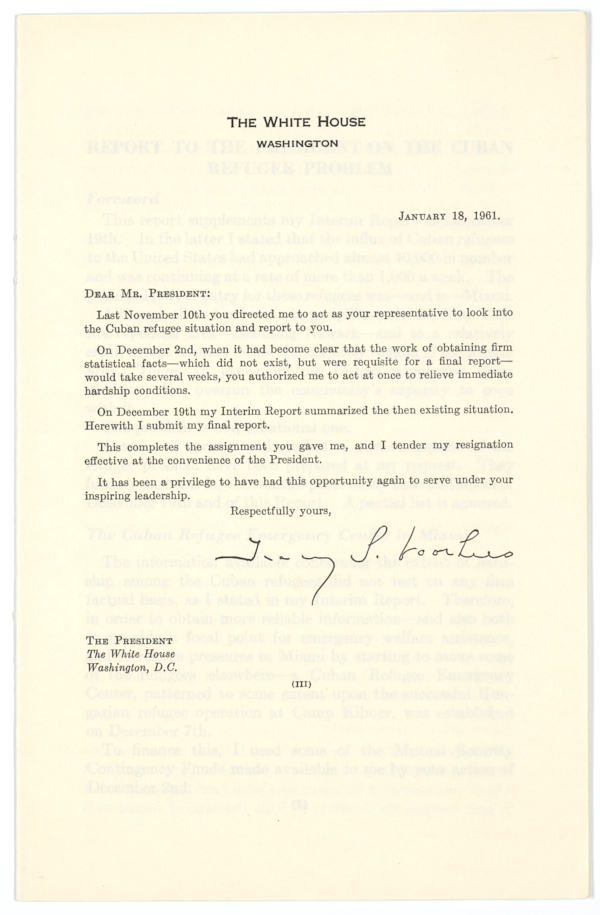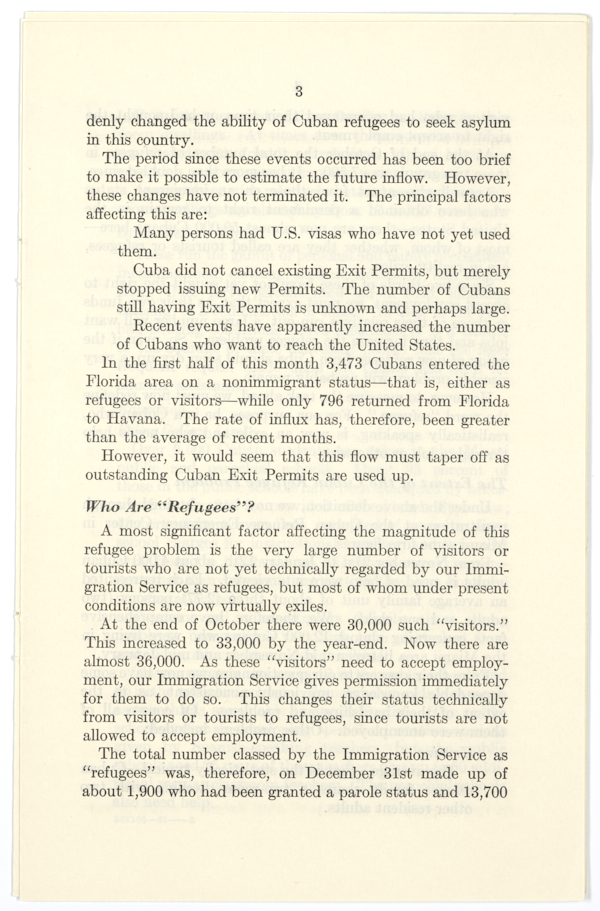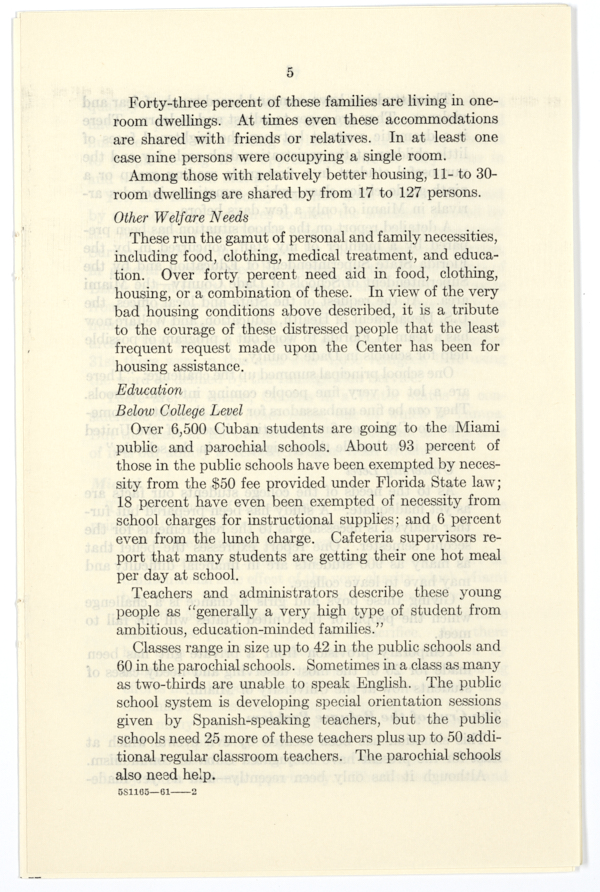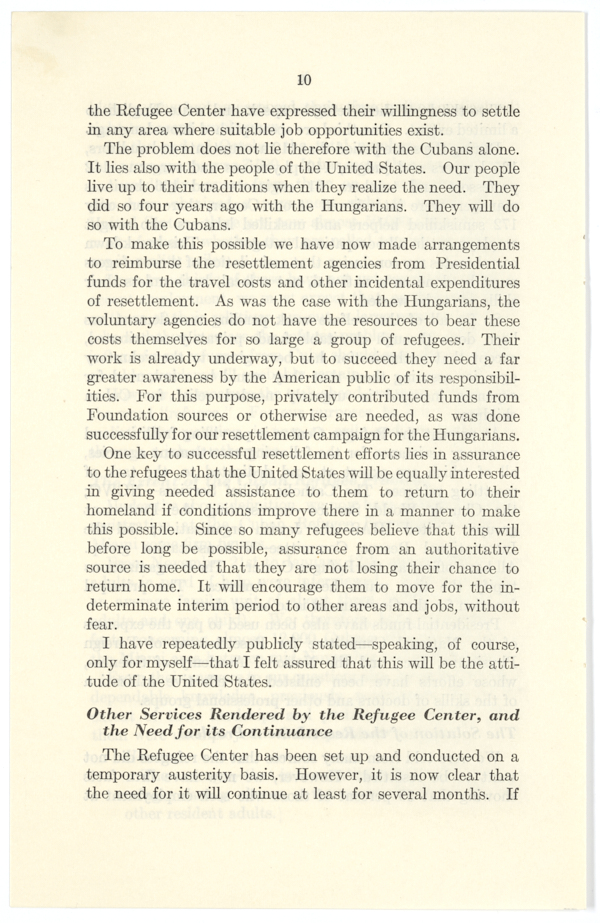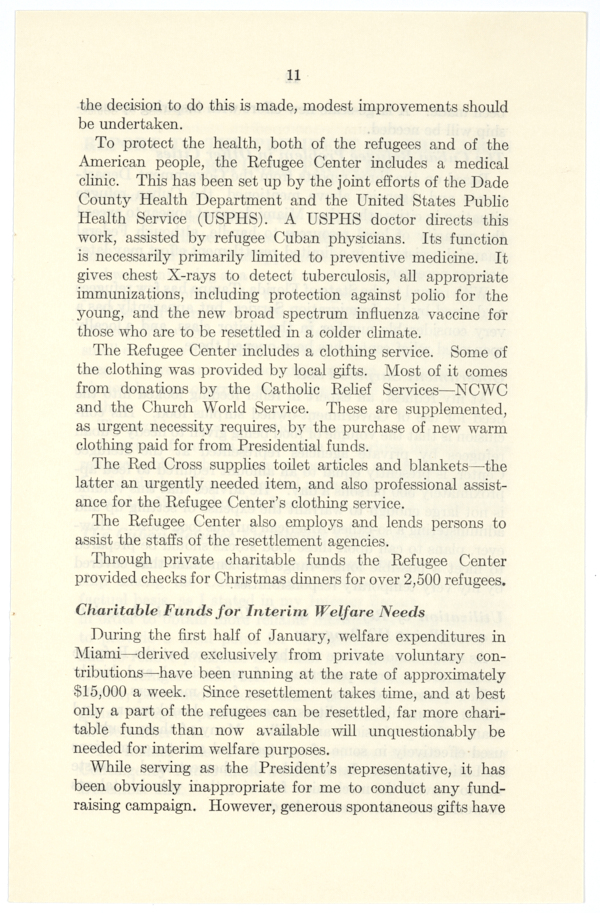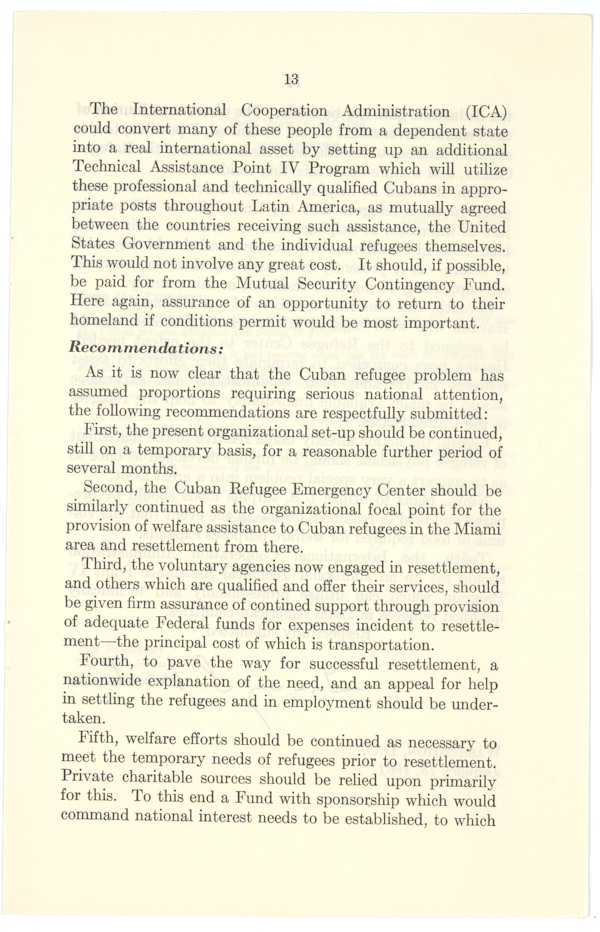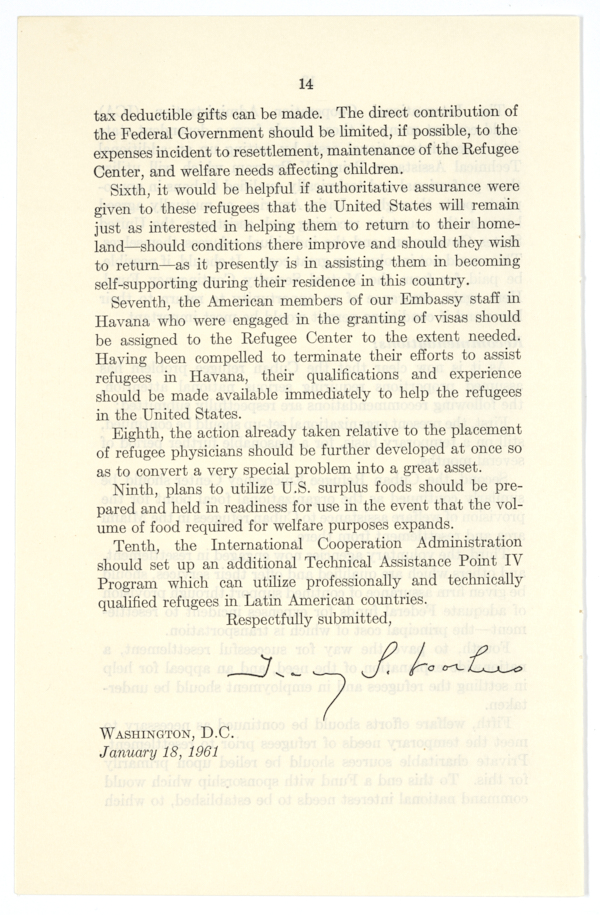Transcript
REPORT TO THE PRESIDENT OF THE UNITED STATES ON THE CUBAN REFUGEE PROBLEM
BY TRACY S. VOORHEES
JANUARY 18, 1961
UNITED STATES GOVERNMENT PRINTING OFFICE
WASHINGTON: 1961
581165
[Stamped] RECEIVED JAN 30 1961
GOVERNOR’S OFFICE
TALLAHASSEE, FLORIDA
THE WHITE HOUSE
WASHINGTON
JANUARY 18, 1961
DEAR MR. PRESIDENT:
Last November 10th you directed me to act as your representative to look into
the Cuban refugee situation and report to you.
On December 2nd, when it had become clear that the work of obtaining firm
statistical facts---which did not exist, but were requisite for a final report---
would take several weeks, you authorized me to act at once to relieve immediate
hardship conditions.
On December 19th my Interim Report summarized the then existing situation.
Herewith I submit my final report.
This completes the assignment you gave me, and I tender my resignation
effective at the convenience of the President.
It has been a privilege to have had this opportunity again to serve under your
inspiring leadership.
Respectfully yours,
Tracy S. Voorhees
The President
The White House
Washington, D.C.
REPORT TO THE PRESIDENT ON THE CUBAN REFUGEE PROBLEM
Foreword
This report supplements my Interim Report of December 19th. In the latter I stated that the influx of Cuban refugees to the United States had approached almost 40,000 in number
and was continuing at a rate of more than 1,000 a week. The principal port of entry for these refugees was--and is--Miami.
Although there has been a large spillover to the New York Metropolitan area--including Newark--and to a relatively small extent to other cities, the majority remain in the Miami area. There, an ever-mounting Cuban population quite obviously has overrun the community’s capacity to cope with it.
The problem is now a national one.
A series of surveys and studies of various aspects of the Refugee problem have been prepared at my request. They furnish the basis for substantial parts of my Interim Report of December 19th and of this Report. A partial list is annexed.
The Cuban Refugees Emergency Center in Miami
The information available concerning the extent of hardship among the Cuban refugees did not rest on any firm factual basis, as I stated in my Interim Report. Therefore, in order to obtain more reliable information--and also both to provide a focal point for emergency welfare assistance, and to relieve pressures in Miami by starting to move some of the refugees elsewhere--a Cuban Refugee Emergency Center, patterned to some extent upon the successful Hungarian refugee operation at Camp Kilmer, was established on December 7th.
To finance this, I used some of the Mutual Security Contingency Funds made available to me by your action of December 2nd.
This Refugee Center has since served as the catalyst required to produce a cooperative effort, without which there could be no hope of success. Here the talents and resources of many public and private agencies have been fused into a major cooperative enterprise making possible for the first time a valid assessment of the problem and the beginning of effective action to meet it.
As a result, the situation in Miami, though still serious and potentially explosive, has already been improved. The state of mind, bordering on desperation on the part of the refugees and grave anxiety in the minds of State, County, and City officials and of responsible citizens, has in general changed to an attitude of hope of confidence that something is being done.
No Cuban refugee in that area is now without an immediate source of assistance if he seeks it. None for the time being need go without food, clothing, housing, emergency medical care, or assistance in finding employment.
The Refugee Center has been thoroughly publicized throughout the area, through both Spanish and English Media, encouraging the Cuban refugees to come in and state their needs. Some 4,000 employable persons have been registered, interviewed and assigned to welfare and resettlement agencies.
Though the process of resettlement has just begun, several hundred refugees representing over 250 family units have already been moved to new homes and jobs in the other communities, and the pace of such resettlement is accelerating.
Concurrently, contributions made from private charitable sources were allocated among the voluntary welfare agencies for use at the Refugee Center and elsewhere to meet immediate and urgent welfare needs of the refugees.
Changed Circumstances
Cuba’s limitation of our Embassy staff to eleven persons, which precipitated our breaking off diplomatic relations, and which was promptly followed by Cuba’s announcement that it had stopped the issuance of Exit Permits, of course sud-
denly changed the ability of Cuban refugees to seek asylum in this country.
The period since these events occurred has been too brief to make it possible to estimate the future inflow. However, these changes have not terminated it. The principal factors affecting this are:
Many persons had U.S. visas who have not yet used them.
Cuba did not cancel existing Exit Permits, but merely stopped issuing new Permits. The number of Cubans still having Exit Permits is unknown and perhaps large.Recent events have apparently increased the number of Cubans who want to reach the United States.
In the first half of this month 3,473 Cubans entered the Florida area on a nonimmigrant status--that is, either as refugees or visitors--while only 796 returned from Florida to Havana. The rate of influx has, therefore, been greater than the average of recent months. However, it would seem that this flow must taper off as outstanding Cuban Exit Permits are used up.
Who Are “Refugees”?
A most significant factor affecting the magnitude of this refugee problem is the very large number of visitors or tourists who are not yet technically regarded by our Immi-gration Service as refugees, but most of whom under present Conditions are now virtually exiles.
At the end of October there were 30,000 such “visitors.” This increased to 33,000 by the year-end. Now there are almost 36,000. As these “visitors” need to accept employment, our Immigration Service gives permission immediately for them to do so. This changes their status technically from visitors or tourists to refugees, since tourists are not allowed to accept employment.
The total number classed by the Immigration Service as“refugees” was, therefore, on December 31st made up of about 1,900 who had been granted a parole status and 13,700
visitors who had overstayed their time or had sought the right to accept employment.
At the end of October the total number of refugees in these two groups was 7,500. It has more than doubled since. Accordingly--apart from those on an immigrant status who have obtained a permanent right to remain in the United States--there are now almost 50,000 Cubans here--most of whom, whether they are called tourists or refugees, are in reality exiles.
Since two-thirds of these have not yet sought the right to accept employment, we must expect that, as their own funds or those of their relatives run out, a large number will want
jobs and thus increase the refugee problem. So, even if the influx of the new refugees from Cuba should soon dry up, a very sizeable problem will probably remain.
However, to measure the task ahead, we must now redefine the word “refugee.” For our purposes, he is a Cuban who, realistically speaking, is now an exile and who needs help
through a job or otherwise.
The Extent of the Cuban Refugee Problem
Under the above definition, we now have obtained through registration at the Cuban Refugee Emergency Center in Miami some firm figures.
From November 21st to January 12th, about 4,000 Cuban adults in need of help were interviewed. Each represented an average family unit of three (2.77) persons (two adults and one child). We, therefore, have comprehensive facts concerning almost 12,000 Cubans who were living in the Miami area between mid-November and mid-January.
From their answers to our questionnaire, we now have some dependable knowledge, previously nonexistent, as to the extent of their hardships and problems. Of course all of them were unemployed. Others problems included:
Housing
The average--that is the statistically typical--Cuban refugee family shares a two-room dwelling with two other resident adults.
Forty-three percent of these families are living in one-room dwellings. At times even these accommodations are shared with friends or relatives. In at least one case nine persons were occupying a single room.
Among those with relatively better housing 11 - to 30-room dwellings are shared by from 17 to 127 persons.
Other Welfare Needs
These run the gamut of personal and family necessities, including food, clothing, medical treatment, and education. Over forty percent need aid in food, clothing, housing, or a combination of these. In the view of the very bad housing conditions above described, it is a tribute to the courage of these distressed people that the least frequent request made upon the Center has been for housing assistance.
Education
Below College Level
Over 6,500 Cuban students are going to the Miami public and parochial schools. About 93 percent of those in the public schools have been exempted by necessity from the $50 fee provides under Florida State Law; 18 percent have even been exempted of necessity from
school charges for instructional supplies; and 6 percent even from the lunch charge. Cafeteria supervisors report that many students are getting their one hot meal per day at school.
Teachers and administrators describe these young people as “generally a very high type of student from ambitious, education-minded families.’
Classes range in size up to 42 in the public schools and 60 in the parochial schools. Sometimes in a class as many as two-thirds are unable to speak English. The public
school system is developing special orientation sessions given by Spanish-speaking teachers, but the public schools need 25 more of these teachers plus up to 50 additional regular classroom teachers. The parochial schools also need help.
These students have seen and heard much of fear and violence. They are eager to adjust and to learn. There is a dramatic contrast between the frightened faces of little children at the registration desk each day and the purposeful student in a first-grade reading group or a
ninth-grade civics class--which sometimes includes arrivals in Miami of only a few days before.
A detailed report on the school situation has been prepared by a member of my staff, concurred in by the Florida State Superintendent of Education and by the Superintendent of Schools of Dade County--the Miami area. At the request of the State and local offices, the
U.S. Department of Health, Education, and Welfare now has a team in Florida to work out a program of possible help for schools in Dade County.
One school principal summed up the challenge: “There are a lot of very fine people coming into our schools. They can be fine ambassadors for us, if they return sometime to Cuba; or fine potential citizens of the United States, if we handle things right here in the schools.”
University Level
As to the needs of the college students our facts are as yet inadequate. A study has been prepared but further analysis is necessary as to the requirements for the second semester. One report expresses the belief that as many as 900 students are in financial difficulty and
may have to leave college.
Giving these boys and girls a chance is a challenge which the people of the United States will not fail to meet.
Temporary provision from a private gift has been made for 20 of the most deserving and needy cases of students now at the University of Miami.
The Crux of the Refugee Problem
This situation has been created by evil events which at least for the present have subjugated Cuba to communism. Although it has only been recently--and as yet inade-
quately--realized, the Cuban refugees present us with a national problem following from our nation’s traditional humane policy of granting asylum as long as they need it
to people fleeing from oppression, however they come in and whatever their status.
Yet, this national policy was not until recently balanced by any adequate measures to meet the situation created by it. Accordingly, the Miami area has been badly overtaxed. Surveys made at my request by the Immmigration Service, in general corroborated by reports by the Departments of Labor and of Health, Education and Welfare, show that aside from Miami the only other community which has any large number of Cuban refugees is the New York Metropolitan area. This includes Newark, New Jersey. On December 31st there were in this area over 4,000 refugees, here using the word as defined by the Immigration Service.
There are, of course, Cubans in a visitor status in considerable numbers in the other cities, one of which is Tampa. But the heart of the problem remains in Miami and the crux of it is our ability to resettle refugees from Miami.
Miami
The seriousness of the situation in the Miami area is due primarily to the following circumstances:
It is the principal port of entry.
The extent of Miami’s problem has been in part an unintentional side effect of the very charity which Miam has shown the refugees. In acts of unexampled kindness, the 50,000 Cubans permanently resident there have taken these people in regardless of sacrifice. Also there has been extensive welfare assistance given both by Religious and nonsectarian groups. While these inspiring efforts have helped thousands of persons in trouble, they did this so successfully through temporary relief measures over many months that, until recently, the United States did not apply long-range curative measures. We must now treat this situation as both a national responsibility and a national opportunity. The United States and
its people must assimilate these refugees, while still keeping open their chance to go home if conditions in Cuba should change.
This resettlement is the challenge now before us. There are no suitable jobs for most of these people in the Miami area. Nor is there room at prices they can pay even to house
them adequately. To attempt to keep all, or even most of them there would also leave very many indefinitely on a relief status.
The Resettlement Problem
Resettlement through jobs elsewhere is, therefore, the key to this situation. Yet this cannot be accomplished overnight. It is a difficult task. Factors making it so are:
The considerable number of Americans now unemployed.
The natural desire of these Cubans to return home if that becomes possible, and their belief that it will be possible at an early date.
Their lack of warm clothing, and their natural apprehensions about life in a cold climate to which they are not accustomed.
To a much lesser degree, the fact that some speak little English.
Also there is a problem--which in reality is a great asset--that so many of these people are in a professional of highly skilled class.
Our Refugee Center and the resettlement agencies have received many job offers in the domestic and service occupational categories. Such offers are in general not suitable for
the professional and vocational education and experience of most of the refugees, but this fact itself should commend them highly to prospective American employers.
Fifty-five percent of the Cuban adults registered at the Center have completed a high school education. Twelve percent are college graduates. Seven percent have advanced or professional degrees. There are over 300 physicians alone, including doctors who are internationally known.
Two-thirds of these refugees speak and write English to a limited extent. One-third are accomplished in are language.
During the same period that 112 accountants and auditors, 125 lawyers and judges, 140 physicians and surgeons, 142 Professors and teachers, 81 engineers and 166 business
managers were interviewed at our Center, there were only 172 semi-skilled helpers and unskilled laborers who sought employment in all occupational categories. This breakdown corroborates my conclusion that assimilation of these refugees must be done on a national, not a local, basis unless their skills are to be wasted.
So far all of the welfare work pending resettlement has been done through charitable funds privately contributed, except that authorization has been given to the voluntary agencies assuring them that they would be reimbursed for expenses incurred in urgently need relief for Cuban children.
At present the Refugee Center is providing facilities and necessary assistance for the following resettlement agencies, all of which are expert at, and dedicated to, the task of
resettling refugees. The Catholic Relief Services--NCWC; the Church World Service--representing the Protestant Groups; United HIAS--the Jewish organization; and the
International Rescue Committee--a nonsectarian group. All have offices at the Refugee Center. These organizations typify the true warm heart of America. The principal function for the Government is to assist them.
Presidential funds have also been used to pay the expenses of the National Committee for Resettlement of Foreign Physicians, Inc., and the National Academy of Sciences,
whose efforts have been enlisted for effective utilization of the skills of doctors and other professional groups.
The Solution of the Resettlement Problem
We were told from many sources that the refugees did not want to be resettled. However, we now have firm facts showing that 59 percent of those who seek employment at
the Refugee Center have expressed their willingness to settle in any area where suitable job opportunities exist.
The problem does not lie therefore with the Cubans alone. It lies also with the people of the United States. Our people live up to their traditions when they realize the need. They
did so four years ago with the Hungarians. They will do so with the Cubans.
To make this possible we have now made arrangements to reimburse the resettlement. As was the case with the Hungarians, the voluntary agencies do not have the resources to bear these costs themselves for so large a group refugees. Their work is already underway by the American public of its responsibilities. For this purpose, privately contributed funds from
Foundation sources or otherwise are needed, as was done successfully for our resettlement campaign for the Hungarians.
Our key to successful resettlement efforts lies in assurance to the refugees that the United States will be equally interested in giving needed assistance to them to return to their
homeland if conditions improve there in a manner to make this possible. Since so many refugees believe that this will before long be possible, assurance from an authoritative
source is needed that they are not losing their chance to return home. It will encourage them to move for the indeterminate interim period to other areas and jobs, without fear.
I have repeatedly publicly stated--speaking, of course, only for myself--that I felt assured that this will be the attitude of the United States.
Other Services Rendered by the Refugee Center, and the Need for its Continuance
The Refugee Center has been set up and conducted on a temporary austerity basis. However, it is now clear that the need for it will continue at least for several months. If
the decision to do this is made, modest improvements should be undertaken.
To protect the health, both of the refugees and of the American people, the Refugee Center includes a medical clinic. This has been set up by the joint efforts of the Dade County Health Department and the United States Public Health Services (USPHS). A USPHS doctor directs this work, assisted by refugee Cuban physicians. Its function is necessarily primarily limited to preventive medicine. It gives chest X-rays to detect tuberculosis, all appropriate immunizations, including protection against polio for the young, and the new broad spectrum influenza vaccine for those who are to be resettled in a colder climate.
The Refugee Center includes a clothing service. Some of the clothing was provided by local gifts. Most of it comes from donations by the Catholic Relief Services--NCWC and the Church World Service. These are supplemented, as urgent necessity requires, by the purchase of new warm clothing paid for from Presidential funds.
The Red Cross supplies toilet articles and blankets--the latter an urgently needed item, and also professional assistance for the Refugee Center’s clothing service.
The Refugee Center also employs and lends persons to assist the staffs of the resettlement agencies. Through private charitable funds the Refugee Center Provide checks for Christmas dinners for over 2,500 refugees.
Charitable Funds for Interim Welfare Needs
During the first half of January, welfare expenditures in Miami--derived exclusively from private voluntary contributions--have been running at the rate of approximately $15,000 a week. Since resettlement takes time, and at best only a part of the refugees can be resettled, far more charitable funds than now available will unquestionably be needed for interim welfare purposes.
While serving as the President’s representative, it has been obviously inappropriate for me to conduct any fundraising campaign. However, generous spontaneous gifts have
been made. A large-scale new effort with inspiring sponsorship will be needed.
The Cuban Refugee Problem in Other Cities
Based on the three reports from the Government Departments and Agencies above mentioned, the Cuban refugee situation in cities other than Miami does not appear to exceed
the capacity of local resources to handle, although Federal financial assistance in a limited resettlement effort may later become necessary.
With regard to the State of Florida,Tampa has few refugees as defined by the Immigration Service, but apparently has a very considerable number in the visitor class, and a locally
sponsored relief center has been opened there.
Government Surplus Food
At my request, an expert in relief feeding looked into the need for use of Government-owned surplus food. His conclusion is that the volume of food being given to needy Cuban Refugees by private agencies represented at the Refugee Center, is presently equal to an amount required to feed approximately 500 persons a day. He advises that this volume is not large enough to warrant the expense of setting up and administering a so-called American surplus food store. However, plans to call upon these food stocks should be prepared
to meet a possible longer-range problem than that covered
by my very temporary responsibilities.
Utilization of Refugees in the U.S. Technical Assistance (Point IV) Program
As noted, among those who have registered at the Refugee Center are a large percentage of professional and highly skilled persons--doctors, engineers, farm managers, economists, agronomists, auditors, secretaries, bookkeepers, and many other professions and skills. Many of these could be used effectively in some of our technical assistance missions in Lattin America. It would be the sheerest kind of waste not to provide the mechanism for using their valuable talents in world work that needs to be done.
The International Cooperation Administration (ICA) could convert many of these people from a dependent state into a real international asset by setting up an additional Technical Assistance Point IV Program which will utilize these professional and technically qualified Cubans in appropriate posts throughout Latin America, as mutually agreed between the countries receiving such assistance, the United States Government and the individual refugees themselves. This would not involve any great cost. It should, if possible, be paid for from the Mutual Security Contingency Fund. Here again, assurance of an opportunity to return to their
homeland if conditions permit would be most important.
Recommendations:
As it is now clear that the Cuban refugee problem has assumed proportions requiring serious national attention, the following recommendations are respectfully submitted:
First, the present organizational set-up should be continued, still on a temporary basis, for a reasonable further period of several months.
Second, the Cuban Refugee Emergency Center should be similarly continued as the organizational focal point for the provision of welfare assistance to Cuban refugees in the Miami
area and resettlement from there.
Third, the voluntary agencies now engaged in resettlement, and others which are qualified and offer their services, should be given firm assurance of continued support through provision
of adequate Federal funds for expenses incident to resettlement--the principal cost of which is transportation.
Fourth, to pave the way for successful resettlement, a nationwide explanation of the need, and an appeal for help in settling the refugees and in employment should be undertaken.
Fifth, welfare efforts should be continued as necessary to meet the temporary needs of refugees prior to resettlement. Private charitable sources should be relied upon primarily
for this. To this end a Fund with sponsorship which would command national interest needs to be established, to which
tax deductible gifts can be made. The direct contribution of the Federal Government should be limited, if possible, to the expenses incident to resettlement, maintenance of the Refugee
Center, and welfare needs affecting children.
Sixth, it would be helpful if authoritative assurance were given to these refugees that the United States will remain just as interested in helping them to return to their homeland--should conditions there improve and should they wish to return--as it presently is in assisting them in becoming self-supporting during their residence in this country.
Seventh, the American members of our Embassy staff in Havana who were engaged in the granting of visas should be assigned to the Refugee Center to the extent needed.
Having been compelled to terminate their efforts to assist refugees in Havana, their qualifications and experience should be made available immediately to help the refugees
in the United States.
Eighth, the action already taken relative to the placement of refugee physicians should be further developed at once so as to convert a very special problem into a great asset.
Ninth, plans to utilize U.S. surplus foods should be prepared and held in readiness for use in the event that the volume of food required for welfare purposes expands.
Tenth, the International Cooperation Administration should set up an additional Technical Assistance Point IV Program which can utilize professionally and technically
qualified refugees in Latin American countries.
Respectfully submitted,
TRACY S. VOORHEES
Washington, D.C.
January 18, 1961
PARTIAL LIST OF REPORTS AND SURVEYS MADE AT THE REQUEST OF THE PRESIDENT’S REPRESENTATIVE FOR CUBAN REFUGEES
1. A continuing series of report on the influx and the location of Cuban refugees
in the United States, by the Immigration and Naturalization Service (INS).
2. Data processing cards from the Cuban Refugee Emergency Center’s registration and interview forms, prepared by the International Business Machines
Corporation.
3. Resolution by the Cuban Refugee Committee of Miami (a citizen’s group).
4. A study of the public school problems created by the influx of Cuban refugee
Children, by Dr. Joe Hall. Superintendent of Schools, Dade County, Florida.
5. A survey of Cuban refugees children in the Dade County public and parochial
schools, by David Mallery (concurred in by the Florida State Superintendent
of Education, and the Dade County Superintendent of Schools). (Further study underway.)
6. A study of the problems of Cuba students in American colleges, by the
World University Service. (Further study underway.)
7. Reports as to the numbers of Cuban refugees in their cities other than Miami, by
the immigration and Naturalization Service (INS), and the Departments of
Labor, and Health, Education and Welfare (HEW).
8. A report concerning clothing distribution, by the American National Red
Cross.
9. A report concerning the possible use of U.S. owned surplus foods, and the
Utilization of Cuban refugees in the Point IV Program, by Stanley Andrews.
10. A report on resettlement of Cuban refugee physicians, by Dr. Robert
Boggs and Mrs. Laura G. Rubin of the National Committee for Resettlement
of Foreign Physicians, Inc.
11. Report and recommendations concerning possible ways of resettling Cuban
Refugee physicians, by Dr. Michael E. DeBakey.
12. A study of the need for a medical clinic at the Refugee Center, by Major
General Silas B. Hays, U.S. Medical Corps (Ret)., and Dr, Arthur P. Long.
13. A report on scientists and Engineers among the Cuban refugees, by Dr.
M.E. Steller of the National Academy of Sciences, Research Council of the
U.S.A.
14. A report on the work of Centro Hispano Catolico, by Monsignor John J.
Fitzpatrick of the Catholic Diocese of Miami.
15. A progress report on the organization and operation of the Cuban Refugee Emergency Center, prepared December 28,1960, by the staff of the President’s
Representative.

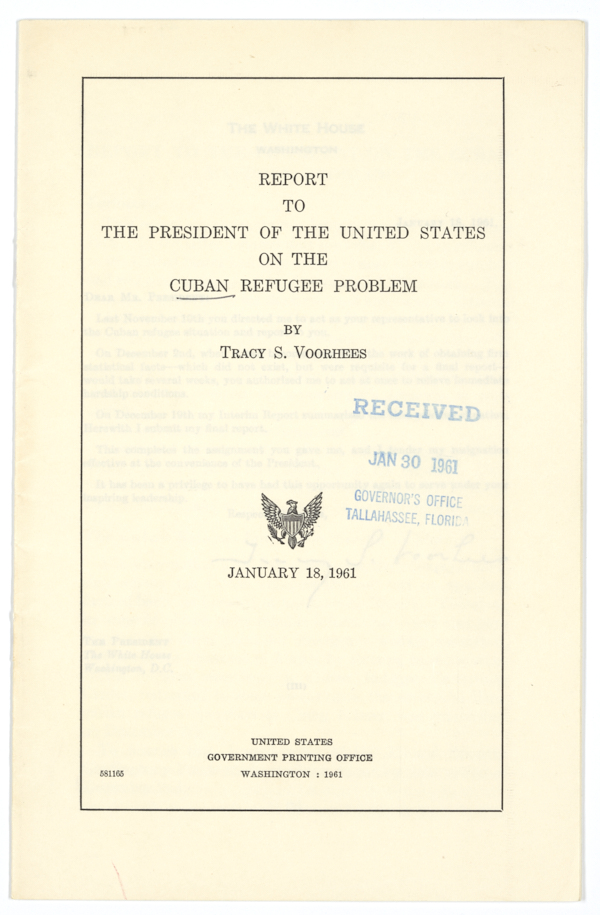
 Listen: The Blues Program
Listen: The Blues Program